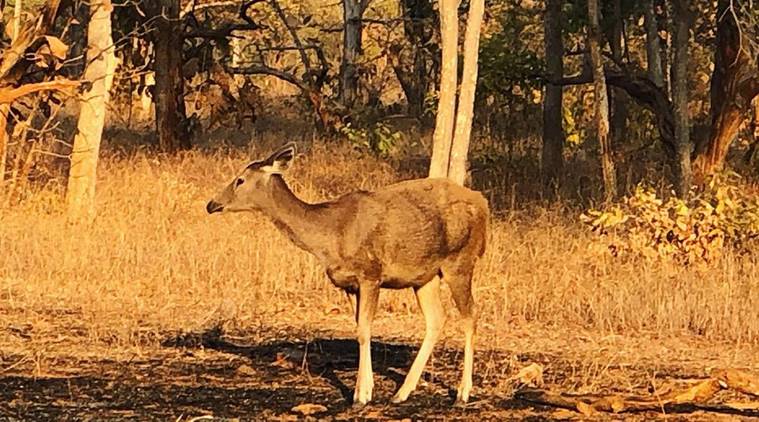
On the first day of this year, P and I were on the night train bound for Khajuraho. We arrived early morning, the small town still sleepy and mist-wrapped, and then drove on to Panna. We were staying at the Pashan Garh safari lodge, about 40 minutes away from the national park. We aren’t in the habit of booking such extravagant holidays for ourselves; this was a first.
From the photographs we saw, it looked lovely, 12 cottages clustered atop a small hill set within 200 acres of wilderness. But in all honesty, I was nervous. I’m a city girl, fond of city holidays that offer history and art and magnificent ruins. Else it’s the mountains, on a bike, exploring, or at the beach, by the sea, with beer, and endless seafood. I hadn’t voiced this to P, but I was wondering — what would we do? Veteran safari enthusiasts might, at this point, balk in horror and disapproval, but I haven’t quite been one myself, perhaps, because I grew up in the wilds of Assam in the 1990s, where we would happen upon leopards on our drive back from the club, or live in tea estates with elephant trails running through them. I went fishing with my grandparents to Bhoroli and Nameri; I could tell changes in seasons from the birds flitting around our lawn.
For me, the wilderness was never a place I had to travel to. Nevertheless, this drive was picturesque. The hills were sheathed in autumnal trees. Panna National Park was spread across a plateau on three levels, and, like most forests in this region, it was dry and deciduous, characterised by thorny woodlands, shrubs and tall grass. Within lived an abundance of wildlife, including — and this was what excited most people — tigers. We’d booked a safari the next day. Would we spot one? We would have to wait and see.
Meanwhile, we arrived at our lodge, surprised by its air of happy informality. They had done away with a “reception area”, and we sat outside, under trees and birdsong, drinking warm lemon honey. Our cottage lay about 300 m below the common area — we were never to walk out unaccompanied at night, and if we ventured out during the day we musn’t forget to carry a whistle. “Just in case”.
The cottages are amid the forest, with a sit-out at the back overlooking a grassy clearing. Down there, we discovered that phone networks and Wi-Fi didn’t penetrate. Our phones fell silent. It felt strange. Suddenly, we had uninterrupted time to sketch, to read, to converse. On our first afternoon, we headed out for a walk with a naturalist.
At this time of the year, the landscape was golden, the tall grass a shimmering sheet, and the trees in winter colours. We hadn’t expected such stark contrasts — blue sky and resplendent oranges and yellows. Our encounters with wildlife was limited to a rotund wild boar taking an afternoon nap behind a rock, fresh chital droppings, and evidence of a bear recently digging up an anthill grubbing for ants. Flora, though, was in abundance — tendu, mahua (flowers from which local liquor is made), achar, seja, salai, bael, and saja, among others, the beautiful kulu, or ghost tree, with its bare silvery branches reaching towards the sky.
The next day, we had the morning free. P slept and sketched, while I read and did a little yoga in our sit-out, my Surya Namaskar observed by a passing family of curious chitals. We didn’t miss our phones, their constant demands for attention. We napped in the winter sun. Later, we were prepped for our safari, driven to the national park entrance, where we met our guide, a cheerful veteran with over a decade of experience. We had another couple for company, and a local “spotter” at the back in the open jeep. This, I had to admit, was exciting. We drove through the gates at 3 pm; we would have to be out by 5.30. At this hour, the birds were out. On trees, a regal honey buzzard, clusters of blossom-headed parakeets, still as a stone on the ground, a jungle bush quail, and at the river, a flurry of bright common kingfishers, flitting like light above the water.
The trail we followed took us near the edge of the plateau, where sheer forested slopes fell to a deep valley. The sun was setting; elsewhere in the park, apparently, a tiger had been heard roaring, but, to our relief, few in our party wanted to rush away. We drove around after this, spotted fresh leopard tracks, and bunches of lumbering nilgai, chital, and pretty, lithe chinkara. After the heat and rush of the day, they were out feeding and drinking. The other jeeps had rushed to where tigers were usually spotted; we found ourselves on our own. Our guide told us, that sometimes, he’d driven people who’d told him to simply park at a nice spot. I felt strong kinship with them. To be here and tread lightly. To intrude upon the forest and its inhabitants, whether human communities or animal, as little as possible. We drove away, wrapping our jackets a little tighter around us. It was back to our quiet cottage, a fireplace, fierce moonlight, and the call of night creatures.